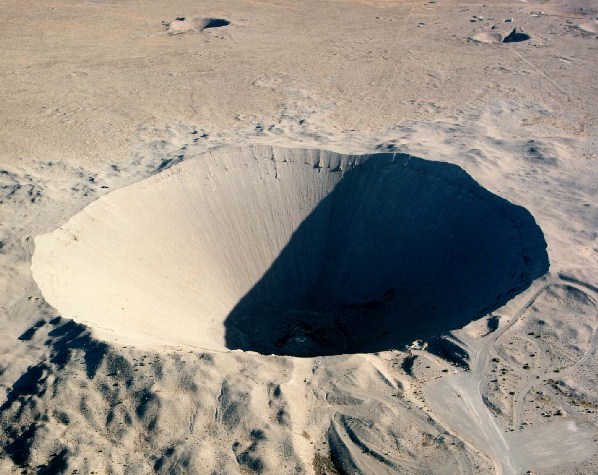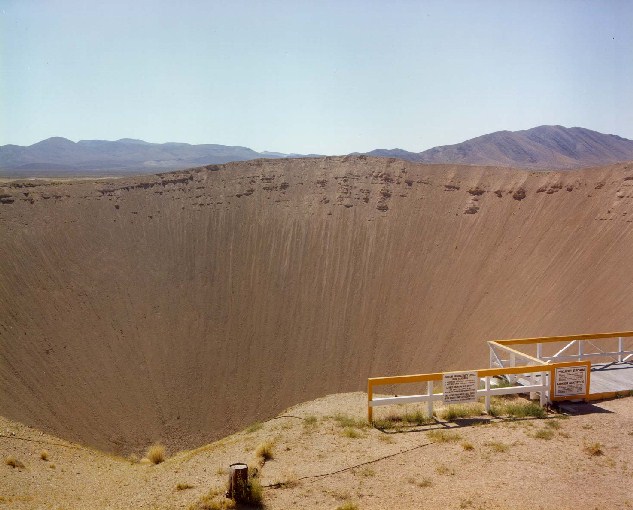
The Hawaiian Islands sit right in the sunglint field in this SeaWiFS image. Note also how the windward sides of the islands are greener (more rain) than the leeward sides.
Posted on 02/20/2004 7:50:03 PM PST by Mike Darancette
It's bad enough when, every few million years, an asteroid rocks our planet. It's worse if the impact triggers regional or global volcanic activity, which is not only hazardous to nearby plants and animals but can choke Earth's atmosphere with deadly gases for months or years.
But there's also a possible bright side, like the birth of nice places like Hawaii.
For more than three decades, scientists have explored the question of whether an asteroid impact could cause significant volcanic eruptions, hot spots that spring up out of nowhere and create new landforms or rearrange old ones. The process might have given birth to the Hawaiian islands, for example. The idea of linking space rocks and lava goes back to at least the 1960s, and in recent months the debate has heated up like a volcano ready to erupt.
The Hawaiian Islands sit right in the sunglint field in this SeaWiFS image. Note also how the windward sides of the islands are greener (more rain) than the leeward sides.
When Kilauea on the big island of Hawaii erupts, it sometimes produces secondary lava fountains, like Pu'u 'O'o.
Though no firm answers have emerged, controversial computer modeling in recent years has shown what might happen, and why.
Old and buried
Andrew Glikson from the Australian National University makes a living by hunting for signs of ancient impact craters, many of which are not readily visible, some of which are buried under oceans that didn't used to be where they are now.
In several recent papers, Glikson maintains that the large craters found so far on Earth only account for about one-fifth of the actual number of major impacts predicted over the past 3.8 billion years. These impact predictions are based on a number of factors, including the vast numbers of craters on the Moon, which don't disappear on the geologically dead and atmospherically challenged satellite.
During these billions of years it is likely that there were at least 10 impacts producing craters more than 125 miles (200 km) in diameter and 30 impacts producing craters more than 60 miles (100 km) in diameter, Glikson figures. And he argues that at least 50 percent of these impacts would have struck locations in ancient oceans where the Earth's crust was much thinner than continental crust and, in particular, some 10 percent would have struck the thin crust adjacent to mid-ocean ridges.
A volcanic eruption is much more likely to occur if an impact occurs at one of these sites and, paradoxically, evidence of the impact is likely to be buried under the eruption and lost forever if that area is later folded, or subducted, into the Earth's crust.
But Jay Melosh, a crater expert from the University of Arizona, doubts this and other links between asteroids and volcanoes. Melosh presented his views last July at a conference on catastrophic events in Vienna.
"There is not a single clear instance of volcanism induced by impacts, either in the near vicinity of an impact or at the antipodes (opposite side) of the planet," Melosh concluded. "The possibility of impact-induced volcanism must therefore be regarded with extreme skepticism."
Researchers who are independently working on various impact mechanisms say Melosh's reasoning is flawed.
Hermann Burchard is a mathematician at from Oklahoma State University. He notes that there are several examples where either a volcanic eruption is speculated to be associated with a known impact or an undiscovered impact is speculated to be associated with a major eruption. Again the problem is that such eruptions tend to obliterate evidence of an impact.
Rocking the other side of the planet
Mark Boslough and his colleagues at Sandia National Laboratories have modeled asteroid impacts. In a 1996 paper, they predicted that the seismic energy from an impact travels through the Earth and is strongly focussed at the antipode to the impact, near the boundary of the crust and the hot, molten mantle.
This, they argue, generates instability in the upper mantle that can produce a "hot spot" under the surface, like the one that continues to form the Hawaiian Islands. They also claim that geologists have no satisfactory explanation for the generation of hot spots by other means, other than that they arise "spontaneously."
Melosh expressed skepticism about the focussing idea after calculating that the seismic energy delivered to the antipode would be insufficient to melt the rocks. Boslough counters that melting is not needed to generate an instability -- the increased temperature of the region may be sufficient to trigger the start of a hot spot.
Clues on the Moon
Dallas Abbott from Columbia University, New York has taken a different approach to the whole question.
Using terrestrial evidence and crater evidence from the Moon, which retains a record of bombardment going back nearly 4 billion years, Abbott has analyzed the timing of large impacts compared with major volcanic eruptions, or mantle plumes.
She found a strong correlation between the two and speculates that large impacts strengthen existing mantle plumes. She describes the ancient and dormant Deccan Traps volcanism, an area that is presently part of India. At the time of the Chicxulub asteroid impact, which occurred in Mexico 65 million years ago and likely led to the demise of the dinosaurs, the Deccan Trap region was near the antipode of the impact.
Others have suggested this coincidence could be possible evidence that impact antipode effects initiated the Deccan Traps.
However, Boslough says the Deccan Traps would have been several thousand kilometers away from the antipode to Chicxulub. Abbott says the Deccan Traps were active well before the Chicxulub impact, and so could not have been initiated by that event, but she observes that the Deccan plume was strongest immediately after the impact and this phase lasted less than one million years.
At the least, it appears to be a strange coincidence.
Despite advances in computer modeling, there is no clear physical evidence of a link between space rocks and lava, but the models are coming up with mechanisms by which an impact could cause, or at least speed up, a volcanic eruption.
And proponents of the idea are quick to point out that geologists have not come up with a better explanation for how the Earth's hot spots got started.
Michael Paine is a member of the Planetary Society Australian Volunteers. Information related to this story and the threat of asteroids can be found at his web site .
Thank you --- on my list now.
The shock waves are radiated in all directions from the impactor. The shock waves travel around the globe and can be additive at the antipodes.
There can be as much damage on opposite side of an island as on the end hit by a tsunami because the wave reinforces itself when it comes together again.
Let me know if you wish to be added or removed from this ping list.
I believe it was reported to have impacted at 35 degrees. (Just a little north of the Mexican city of Merida)
Good god, PC speak has so thoroughly invaded and corrupted our speech that we noe refer to the moon as "Atmospherically challenged".
Quite humorous actually. As to Michael Paine, I assure you that he is NOT p.c.
I am about as Right-wing un-PC as one can get, and I even catch myself saying things like this these days.
I mean, a mile is very small compared to Earth. This is akin to a penny shredding your house if it falls from the sky.

Because it is going really fast.
Remember, an object coming in from space is going to be traveling at extremely high velocity. When the object suddenly decelerates upon impact or when the sheering forces tear it apart, its massive amount of kinetic energy (energy of motion) is instantly converted into thermal energy (heat energy). This instant conversion creates an explosion that can be as great or even thousands of times greater than the largest nuclear weapons ever built.
The event at Tunguska was estimated to have been caused by an object roughly 50-100 meters in diameter. Far less than 1+ miles in side. While Tunguska thankfully didn't hit the ground, it detonated in the air around 15,000-25,000 feet. When it exploded, it was traveling around 7 miles per second. The force of the explosion has been estimated to be anywhere from 15 megatons up to 40 megatons. (Most experts agree somewhere around 20-25 megatons is the most likely.) Think about how much damage something like this could do if it hit the ground or a populated area. Hiroshima was only 12.5-15 kilotons. (1,000 kilotons=1 megaton) The explosion at Tunguska also created an detectable electromagnetic pulse which damaged electric equipment (telegraphs, phone systems, wireless) at very long distances from the blast site.
We all know about Meteor Crater in Arizona. A somewhat smaller object created this giant hole.

Now compare it to Sedan Crater which is at the Nevada Test Site. It was created by a 104 kiloton test (around 1/10 of a megaton) in 1962.


Disclaimer: Opinions posted on Free Republic are those of the individual posters and do not necessarily represent the opinion of Free Republic or its management. All materials posted herein are protected by copyright law and the exemption for fair use of copyrighted works.